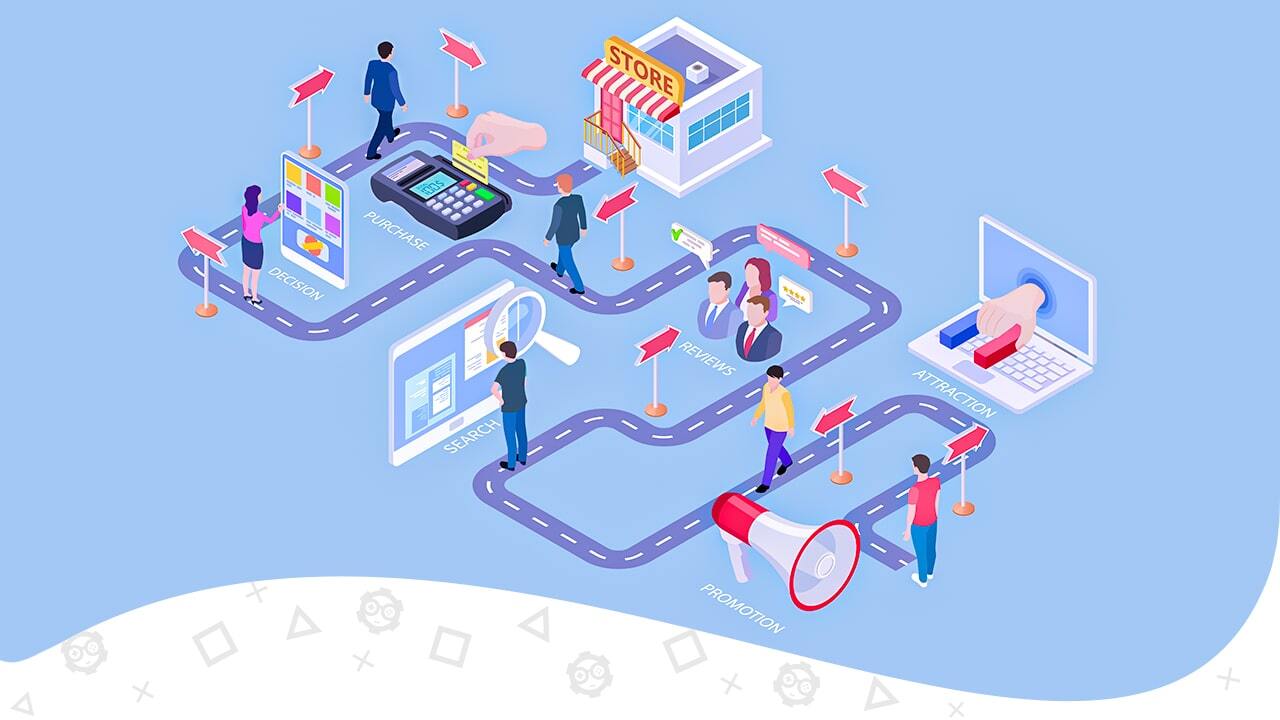Understanding customer journey mapping gives you a durable, competitive advantage. Customers have more channels to interact with brands than ever. So, how do you ensure that they are getting a seamless customer experience in this noisy world? And more importantly, how do you ensure that they don’t skip you for another brand?
Read also: Why competitor analysis is important
One way to achieve that is by understanding, creating, and using customer journey mapping. It will help you visually analyze how your customers interact with your brand during different stages of their entire customer journey.
This information, then, can be used to increase customer retention and make the best business decisions.
In this post, we will cover:
- What is customer journey mapping?
- Why is it important?
- How to create one for your brand?
What is Customer Journey Mapping?
A customer journey map is the visual representation of the steps customers go through to achieve a goal with your company. This fundamental concept allows organizations to see their business from the customer’s perspective.
The process of creating this visual representation is called customer journey mapping.
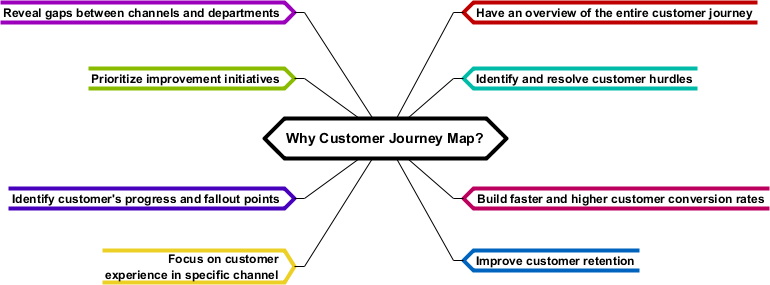
Understanding the customer journey theoretically won’t be enough. But when you map it into diagrams, you and your team can use it as a resource and see customer touchpoints from different perspectives. By mapping the customer journey, you can better understand these customer motivations and improve them.
Customer journey is no longer linear. Instead, we often face back and forth, cyclical, multi-channel journeys. So when creating a map for your customer journey, make sure that it makes sense to whoever is going to use it.
First, you plan the details of different ways a customer can interact with you. This may include social media, email newsletter, advertising, etc.
Then, you define how customers from different buyer personas can interact with your brand using these touch points. For example, a baby boomer buyer persona might get to know your brand from a banner ad, research it on their laptop, and finally, make the purchase by directly accessing your website using their mobile device.
Make sure to include every touchpoint in the customer journey map. For example, this may consist of a customer reaching out to you through Facebook Messenger with a query and how you respond to it.
Why Is Customer Journey Mapping Important?
Now that you know what customer journey mapping is, let’s dig deeper.
It is essential to understand the customer journey and their decision-making process in order to provide the customer satisfaction they are looking for.
People just don’t want to interact with your business. They want to feel that the customer experiences were good enough to come back. So it’s all about understanding each customer’s needs to build a good relationship with them.
Turning one-time buyers into repeat clients looks easy on paper, but it can get a little overwhelming to understand the whole process. Nonetheless, you have to understand various nuances of customer needs, problems, and interactions and add them to your long-term improvement strategies.
Customer journey mapping plays a vital role in achieving that. Fortunately, it is not as complex as it seems. Using visual storytelling helps you understand how customers interact with your brand. You can eventually use the insights from it to improve customer retention and business decisions vital for your company’s growth.
Companies with a customer journey management program have seen the following year-over-year changes as compared to other companies:
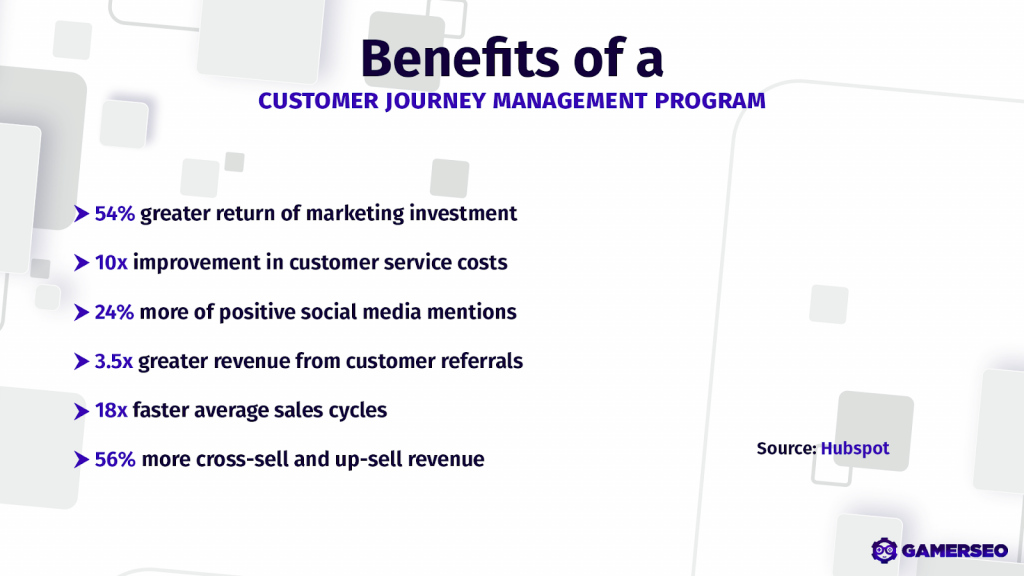
If you map your customer journey, you’ll get several benefits. We include only a few of them here:
It Helps Personalize Customer Experience
Consider personalization. This marketing concept has gained a lot of traction because of social media marketing. Businesses have the opportunity to market their products based on the data they learned about an individual. Customers are demanding these tailored experiences.
Treating your customers as a number is not going to cut it in 2021 because 84% of consumers think that being treated like a human is crucial to winning their business.
And if you are providing relevant recommendations to consumers, 91% of them are more likely to shop from you. Customer journey mapping will help you create tailored experiences for all individuals vital for success these days.
It Helps You With Inbound Marketing
We won’t get too much into the outbound marketing vs. inbound marketing debate, but let’s make it clear that outbound marketing can be annoying because it targets generalized or uninterested audiences.
Compare it to inbound marketing, where you create relevant content so that you can get quality traffic.
When you have created a customer journey map, you have a clear view of your customers’ needs and what turns them away. You can use this information to create content that grabs customers’ attention first and focus on sales later.
READ ALSO: Why Invest in Content Marketing: 8 Data-Supported Reasons
You Can Have Dedicated Customer Service
A customer journey map tells you about the points where you are doing well as well as where customers might be facing friction.
When you know this information beforehand, you can implement strategies to respond to any queries or resolve any issues. In turn, it will make you a trustworthy brand.
Including your contact details such as phone number and email address on your site is obvious.
But when your customers know that your employees pick their phone calls no matter if it’s a holiday, you become reliable. You can also implement an additional combination of support resources or solutions if your leading support teams are unavailable for any reason.

Don’t waste any chance to give a smooth customer journey experience. It gives you opportunities to attract a new prospect for your business and get fantastic customer feedback.
You Can Have Higher Customer Retention
More pain points make people leave your brand and pick a competitor. But when you already know your customer journey and have mapped it out, you know which points need to be improved.
Customer retention is always a better approach than acquiring new customers. Statistically speaking, it can cost you 5-25 times more money to acquire a new customer than retaining an existing one.
Is Customer Journey Mapping Right for My Business?
By now, you know that understanding and mapping customer journeys is essential in creating a seamless customer experience. But there’s a misconception about it: it’s more important for larger B2B companies. However, this couldn’t be further from the truth.
Do you think about company size when you are figuring out customers’ expectations? Regardless of the size of your business, you make efforts to understand it and create the best experience for your customers.
On top of that, customers expect an omnichannel approach to customer service, marketing, and sales from businesses of all kinds. So the idea that customer journey mapping is not important for small and medium-sized enterprises is trivial.
Don’t let someone convince you that if you map customer journeys, you are wasting your time. They might tell you that understanding customer pain points theoretically is enough.
However, when you break these pain points phase by phase and map them into a diagram, you come across important details for long-term customer success.
Create a customer journey map using the following steps that we’ll discuss in this article.
How to Create a Customer Journey Map?
You won’t come across two different businesses using the same customer journey map templates. That’s because each business has its own needs. You can also use different types of customer journey mapping tools. However, the following steps are common to creating a customer journey map for any kind of business:
Create a Customer Persona
Customer personas (also known as buyer personas) are fictional characters representing your ideal customer’s traits. You figure out these traits using market research. When you understand the age, job function, goals, and other things about your target audience, you can understand their problems and what they want from you.
Getting feedback from customers can help you figure out your customer persona. Be sure to find people that are actually interested in your products and services. Then, you can ask them questions like these:
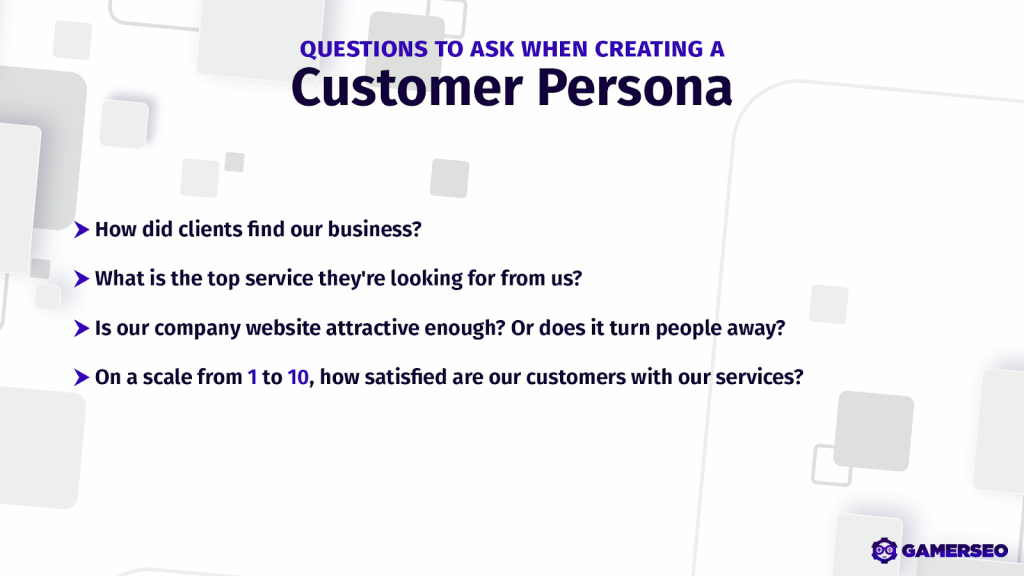
Based on questionnaires and market research, create three personas that can help you find your ideal buyer.
Decide What to Measure
Next, you must focus on your goals. Now, these goals are not final. You can change them over time because your customer journey map is customizable. But for now, figure out what you’re trying to achieve.
For example, you want to figure out your consumers’ feelings when going through your sales funnel. Or maybe, you want to look at if your customer service is performing at its best.
Define Customer Touchpoints and Customer Stages
Pay special attention to this step because it can make or break your customer journey map. Be sure to cover the following things:
- Identify all touchpoints: Touchpoints are all spots where a consumer can interact with your brand. It can be your websites, social media, ads, emails, third-party reviews sites, or mentions. When you know all these touchpoints, you can identify patterns in how people feel at each interaction.
- Write down the phases: Whenever someone interacts with your brand, there’s an action behind it motivated by emotion. Writing down these phases will help you to give the right experience at each stage.
Don’t get overwhelmed by all these steps. Eventually, they’ll help you improve your business. You can start by using Excel sheets to organize your maps.
Prioritize and Fix Roadblocks
Next, you want to fix roadblocks that are preventing customers from converting. Looking at things closely will help. For instance, you can start with basic questions like these:
- Does something need to be built from scratch?
- What needs to be entirely reconstructed?
- Or will a simple tweak do the job?
For example, if you constantly hear complaints about your payment processing method, consider changing it with a better option. Or, if the frequency of your emails is so high that it’s getting annoying for customers, try sending fewer emails.
After looking at things closely, have a bird’s eye view. Remember that you don’t want to optimize things just for the sake of optimization; you should optimize them for the sake of getting more conversions. At the end of the day, our ultimate goal is to get more conversions.
Update and Improve
To experience customer journey mapping and its effects, don’t leave it like that. It’s a sign that you are not getting the most out of it. Instead, update and improve it over time because your customers are constantly evolving.
Treat it as your business plan; if you are changing it with the ever-changing marketing campaigns, your customer journey map should continue to grow and develop as well. Try testing it every six months. And don’t forget to change it when you change something in your product or service.
Customer Journey Map Examples
Now, let’s look at a couple of examples from different fields. These are different in approach and detail, so they will inspire you to create a map that fits your business.
GamerSEO – Gaming Customer Journey Map Example From an SEO Perspective
GamerSEO has created this example for the gaming industry from an SEO perspective. But the concepts can be applied to other industries as well.
Most of the time, you’ll find SEOs focusing on addressing the queries (keywords) in their content without thinking about the end-user searching it.
But with a customer journey map like this one that addresses all stages of a customer, you can create way better SEO content.

This example should clarify it. Let’s say that you want to create content around these two long-tail keywords: 1. “Is a free VPN good enough?” 2. “Where to buy a gaming VPN?”
If you have mapped out the customer journey as we did, you’d know which keyword lies in the “I want” stage and which keyword lies in the “I look for” stage.
After that, a quick analysis will show you what keywords are more in demand, what is the market supply, and how you should approach them in your content strategy?
This is How a Classic Customer Map Looks Like

Travel Mate analyzed the customer’s journey for Carnegie Mellon University. It features tailored reminders and suggestions for its students during different stages of the trip.
The institute also included changes for each phase and outlined example scenarios for each phase. It clearly shows the university’s vision and helps each department align with that vision.
Retail Customer Journey Map Example
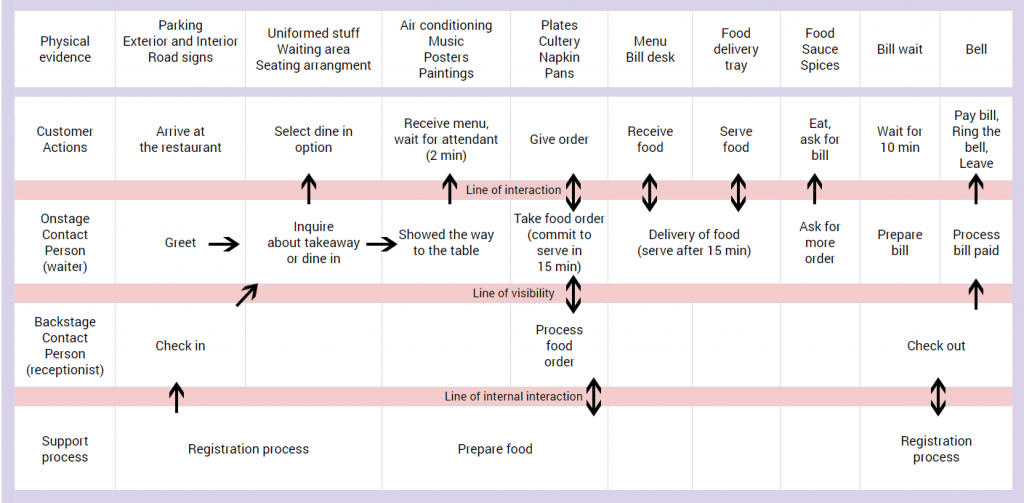
This map is designed for a fictitious restaurant. However, it can be used as an inspiration for real businesses. Typically, customer journey maps will outline direct interactions with customers. But what makes this example unique is the fact that it features non-direct or invisible interactions with customers. It also includes a support process.
This map may look more complicated because it includes every point in customer experience. But when you have a comprehensive visual like this, you get insights into the root cause of mishaps, which can be used to improve services over time.
Customer Journey Map of a Potential Gamer
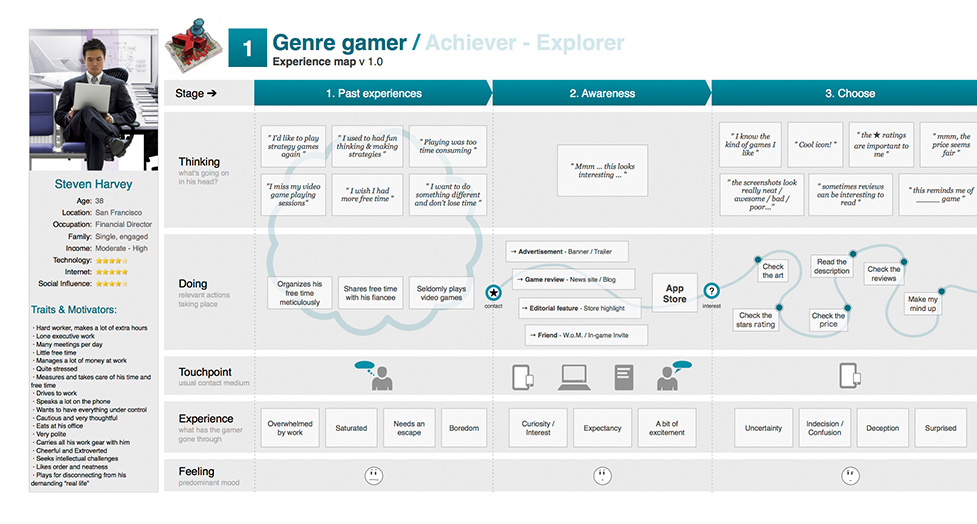
It’s quite a simple example. It shows the data and analysis of a potential gamer whose day job is related to finance.
You’ll find the aims and motivations of this buyer persona in it. It also features the gaming experience of the target audience. This type of map is a good starting point for improving the user experience.
READ ALSO: Advergaming Examples – How Games can give you Sales?
Conclusions
Simply put, knowing your customer journey means that you know your customer engagement and behaviors very well. Employees from different departments, whether a sales rep or an entire team of marketers, should understand the customer journey, buying stages, and emotions attached to it.
Get into the shoes of your ideal buyer. Think about how that person feels when interacting with your brand, whether in the awareness or advocacy stage.
Understanding your customer journey better and visualizing it in the form of customer journey mapping will ensure that you have a complete picture of your customer.
And more importantly, you’ll be able to see your business from a customer’s perspective, which is vital for conversions. So, do you want to level up your marketing strategy? Let’s talk now! We know how to map a memorable customer journey for all of your clients.
FAQ
What Is Customer Journey Mapping?
Customer journey mapping is the process of creating a customer journey map, a visual representation of the steps customers go through to achieve a goal with your organization.
Why is Customer Journey Mapping Important?
Customer journey mapping has different benefits, such as a focused inbound marketing approach, proactive customer support, and a higher customer retention rate. But arguably, the most important benefit is understanding your customer more.
How Can You Use Customer Journey Mapping to Improve Customer Experience?
Today’s consumers demand personalized approaches to marketing on every platform. When you understand your customers well using a customer journey map, you can target them across multiple touchpoints. Consumers will get an amazing customer experience on various platforms, such as social media, messenger apps, or live chat.
Full-time workaholic with four years of experience in Content Writing and Copywriting. Creating texts that bring sales, content that’s worth reading, and paying attention to detail is his key to provide quality and results. On-page SEO enthusiast and voice-over in his spare time.

